#tipping etiquette
Text

6 notes
·
View notes
Text
The New Tipping Etiquette: How Much to Tip in Every Situation, from Salons to Restaurants to Drivers and Delivery
— Charlotte Hilton Andersen | March 15, 2024
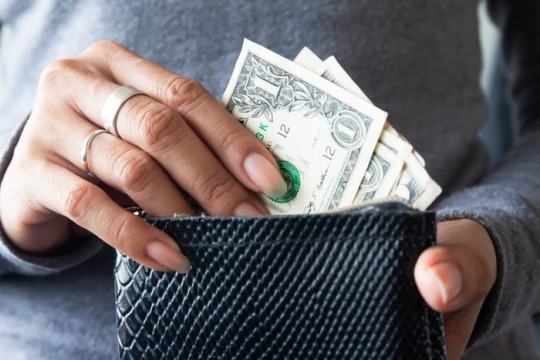
Anon Krudsumlit/Getty Images
The pandemic changed tipping etiquette. Here's what you need to know about when, what, and how to tip now.
For Americans, knowing how much to tip has always been stressful—there are no set rules, so you’re left guessing how to convert service quality into cash and avoid making any tipping mistake—but all the contactless delivery options and other new protocols that popped up after the pandemic have only increased the confusion. Many workers who often make less than minimum wage, normally survive on tips, like waitstaff at sit-down restaurants, hotel clerks, and bartenders, lost this large part of their income when they no longer served customers in person, says Toni Dupree, a professional etiquette coach and author of a book and magazine column on etiquette rules and tipping culture.
But while tipping for in-person services stopped during the height of the pandemic, other types of services exploded. Suddenly things like food and package delivery and grocery pickup were considered safety essentials. Places that had never asked for a gratuity before, like fast-food restaurants and coffee shops, were now asking for tips. Digital tipping systems that have increased throughout the pandemic have led to a phenomenon of tipflation, putting stress on everyone’s personal finances. And newer service jobs became popular, like concierge health care, where doctors and nurses come to your home to do exams.
Did all these new services require a tip? Should the tip be bigger since these “essential workers” were working during a pandemic? Should tips depend on how risky the job is? And let’s not forget about the hit to most of our wallets. Money has been getting tighter for many people, particularly those who lost their jobs. Should folks on a reduced income still be expected to tip everyone in the service industry regardless of the quality of service?
Then there’s the age-old question of how much to tip hairdressers versus how much to tip hotel housekeeping versus how much to tip movers versus—well, you get the idea. It got really confusing, really fast. “It began to feel like there was no rhyme or reason at all to tipping,” says Dupree. “We were just tipping based on emotion, and that may or may not have had anything to do with the actual service.”
We’re here to answer all those questions and more so you know just how much to give in thanks for services rendered well. When you’re done with this article, test your smarts with our quiz: Do you know how much to tip?
Old Etiquette Rules No Longer Apply
The rules about whom, how, when, and how much you should tip have changed, says Lisa Grotts, a certified etiquette professional, author of several books on etiquette, and the former director of protocol for the city and county of San Francisco—a job where she oversaw national and diplomatic etiquette protocols, including tipping.
Here’s What Has Changed:
Whom you should tip. There are more types of service workers that should be tipped.
Amount of the tip. Many people are giving far more generous tips.
The type of tip given. In addition to cash, more people are “tipping” with gift baskets, prepackaged foods, thank-you notes, and gift cards.
The situations in which we tip. Food-service tips moved beyond gratuities for waitstaff and now include tips on pickup and virtual orders or tips for the restaurant owner. New tipping situations have become common.
The tipping method. Many service people now prefer virtual tipping through Venmo, PayPal, Square, and other electronic apps that allow you to transfer money to someone personally and immediately.
What businesses do with the tips. More businesses are asking for tips, and it has become more common for tips to be divided between all the workers at an establishment, including those not directly interacting with customers.
Tipping Guide: How Much To Tip In 2024
We’ve compiled the best tips on tipping in the United States from our experienced etiquette experts. Here’s the lowdown on whom, when, and how much you ought to tip.

RD.Com
Restaurant Takeout: When the pandemic hit, a lot of in-person restaurants sold takeout only, prompting people to wonder: Do you tip for takeout? The answer is yes. You should tip restaurant workers for all orders, including takeout and delivery. Tip in high-end as well as casual restaurants.
Tip: 10 to 15 percent of the total check
In-Person Restaurant: Tip your waiter or waitress if you dine in but also tip anyone who assists you in getting your food, as waitstaff often do many jobs now. That’s just good dining etiquette.
Tip: 15 to 20 percent of the total check
Food Delivery: Tipping is now expected for all types of food deliveries, including DoorDash and UberEats. Most delivery drivers prefer to be tipped through the app, and this is often done when the order is placed, before the delivery happens. So, how much should you tip for pizza delivery next time you get a craving for a warm, cheesy pie? It depends on your bill’s total, but the below advice is a good rule to follow.
Tip: 10 to 15 percent or $2 to $5, but consider increasing the amount if the weather is bad, if you live far away, or if your order is large.
Personal Grocery Shoppers: The pandemic popularized services like Instacart, where you place an order online or through an app and then someone else does the shopping for you. Tip your shopper, even if you go to the store and pick up the delivery yourself. Tips in the app are preferred, but cash is acceptable.
Tip: 10 to 15 percent of the bill or, if tip is already included, a few dollars extra
Bartenders: Consider tipping generously, as it is more common now for bartenders to have to split their tips with everyone working that shift.
Tip: $2 per drink or 10 to 15 percent of the bill
Baristas: Your spare change dropped in a jar on the counter used to be enough, but now tipping is expected.
Tip: $1 per drink or more if your order is complicated
Hospitality
Hotel Housekeeping: Tip daily, leaving cash in an envelope marked for the housekeeper or with “hotel housekeeping” written on the front.
Tip: $1 to $3 per night, plus $5 for any extra services, like an emergency razor
Valets: Tip cash when you hand over the keys. How much to tip a valet depends on whether you have special requests; if you do, tip more.
Tip: $5 to $10
Doormen: Doormen do a lot more than simply hailing cabs these days, so take into account how much work they do for you. Also take the weather into consideration.
Tip: $5 to $20
Bellhop: Tip per bag and a little extra if they take your luggage all the way to your room.
Tip: $2 to $3 per bag, and $5 for room delivery
Home Deliveries
Amazon Delivery Drivers: Amazon drivers are allowed to accept tips, but it isn’t expected. Consider a tip if you have things delivered more than twice a week. Bottled water or juice and prepackaged snacks left on your porch is a nice gesture too.
Tip: $5 to $20 in cash in an envelope if the delivery is extra large
USPS Drivers and Mail Carriers: The United States Postal Service has updated its rules about what employees can and cannot accept—gifts need to be under $50 per year. Here’s what you’re legally allowed to gift your mail carrier. There’s no limit on thank-you notes though!
Tip: No tip on individual deliveries but a small gift or cash at the holidays is always appreciated.
Furniture and Appliance Delivery People: The amount of the tip depends on the size of the package and what kind of work was done. For instance, tip more if they installed an appliance, put together furniture, or removed old items for you.
Tip: $20 or 15 percent of the price
Special Delivery People: Workers who deliver special-occasion items, like flower bouquets and gift baskets, are generally tipped by the person who ordered the gift, but it’s kind to consider offering them a tip as well.
Tip: $5 to $10 cash
Movers: Even if your company is paying for your move to a new house, you should tip movers. It’s also nice to provide cold drinks and food for movers.
Tip: $20 per person per day and $50 for a supervisor
Salon and Spa Services
Hairstylists and Barbers: Tip your stylist, barber, and their assistants. One of the biggest salon etiquette mistakes you can make is walking out after a haircut without handing your stylist and the assistant who washed your hair some money in thanks.
Tip: 15 to 20 percent, plus $5 to $10 for the assistant
Nail Technicians: Tip for all services, including manicures, pedicures, foot massages, and polish changes. How much to tip for a pedicure, manicure, and the like depends on how much work is done.
Tip: 10 to 20 percent, but skew higher if you have special nail art done
Massage Therapists: How much to tip a massage therapist will depend on the overall cost of your massage. But keep in mind that extra cleaning protocols have added more work to a typical massage and consider tipping a little more generously.
Tip: 15 percent of the cost or $20
Personal Services
House Cleaners: You should certainly tip house cleaners during the holidays or for extra work, but many people are now adding a small tip for each cleaning done well.
Tip: 15 to 20 percent of the bill
Business Managers or Owners: Some people have recommended tipping the salon owner in addition to the stylist or manicurist. But it’s more common now for small business owners to require any tips earned by individual employees to be shared with the rest of the staff, so tipping the boss separately is unnecessary.
Tip: No tip is required, but if service is spectacular, consider writing the owner a thank-you note and leaving a five-star online review.
Lyft, Uber, and Other Rideshare Drivers: Do you tip Uber drivers and other rideshare service drivers? You betcha. You can still tip cash to the driver at the end of the ride or tip electronically through the app (it often will suggest an amount). Tips are generally more generous now than they were previously.
Tip: A minimum of 15 to 20 percent of the bill
Home Service Providers: Plumbers, painters, HVAC specialists, carpet cleaners, appliance repair people, handymen, and other people who do odd jobs in your home generally include everything in the final price, but you can tip if you feel like the service was extraordinary.
Tip: A small gift, a thank-you card, or $10 to $20 in cash
Pet Care Providers: How much to tip a dog groomer, dog walker, or pet sitter depends on the cost of the service, but etiquette rules dictate you tip something. It isn’t necessary to tip veterinarians or vet techs, however.
Tip: 10 to 15 percent of the bill
Personal Trainers and Fitness Instructors: No tips are necessary for a regular training session or class, but consider tipping at the end of a package of sessions, like eight weeks. Group fitness instructors do not expect tips, but the occasional gift is always appreciated.
Tip: $10 to $20
Gift Cards: When you purchase a gift card in the amount of the service—say, when buying a massage or restaurant dinner for a friend—be sure to add the tip amount onto the gift card. This makes it easy for the person using the gift card to pay for the service and the tip. Without gratuity included, many people forget to tip on gifts.
Tip: 10 to 20 percent of the service charge
When in Doubt, Tip
There are many other situations in which tipping may be appropriate, and if you’re in doubt, offer a tip, says Dupree. “One of my favorite quotes, by George Eliot, says, ‘What do we live for if not to make the world less difficult for each other?’ Tipping well is one way to make things a little easier for someone else.”
When To Skip The Tip
While service workers appreciate—and often rely on—tips, not everyone should get a monetary bonus. In addition to USPS drivers, many government workers aren’t able to accept tips. You don’t need to tip teachers, health care providers, or professionals like lawyers and accountants.
Other Tips on Tipping:
Before you tip, check if gratuity has already been added to your bill.
Calculate how much to tip based on original prices, even if it’s happy hour or your order has a discount.
If you want to become the beloved regular at your bar, tip bartenders generously (50 percent). For the same title at a coffee joint, put $5 straight into the tip jar. Being friendly and starting conversations will also get you remembered, and getting on the employees’ good side could get you a free drink in the future.
Don’t leave your tip out in the open. Give it to the server directly, put it in the holder the check came in, or use a credit card.
Don’t be shy about tipping more if you receive excellent service.
If people can’t or won’t accept tips, still give them a handshake and a sincere “Thank you.”
If you’re traveling overseas, read up on tipping guidelines. Tipping etiquette around the world differs from etiquette in the United States
— Charlotte Hilton Andersen is an award-winning journalist who covers etiquette, relationships, psychology, health and lifestyle. She has written more than 50 etiquette stories for Reader’s Digest, spearheading the site’s popular Polite Habits and Best Messages series. With a knack for capturing the essence of an interview subject, she also specializes in human-interest and “as told to” stories. In addition to Reader’s Digest and The Healthy, her work has been published in Shape, Cosmopolitan, Women's Health, O Magazine, Fitness, Redbook, Seventeen, What to Expect When You're Expecting and more.
0 notes
Text
Apparently much-needed reminder that reposting artists' art (by saving the images or screenshotting them and reuploading them yourself) on other platforms without the artists' expressed permission and without credit is theft and an insult to their passion and craft. You are profiting (in views, in attention, in feedback) from someone else's work and ideas, who do not get that feedback for sharing their creation.
If you are an art reposter, you are a thief and I have no respect for you.

#learn basic internet etiquette i am begging but also holding a knife. yes i'm mad. more about others than myself.#do you know how many artists i have seen leave social media because their art started being reposted all over?#tip: way too fucking many#i've had many people tell me about people reposting my art on tiktok#no one ever asked to repost my art on tiktok. ever. they just save super fried bad crunchy jpegs of my art and repost them#they get 20k likes and don't even bother naming me#also a reason i started signing my name more legibly and why my blog web address is always there but apparently no one can even read that#a few people got an ok for translations on other platforms though#i'm going to be annoying with this post and reblog it a few times to try to catch the people who apparently need to be told#tiny skk adventures#nawy's comics#nawy's doodles#apparently those are reposters' favourites so here look at this
4K notes
·
View notes
Text
Using this anon hate I got as a teaching example
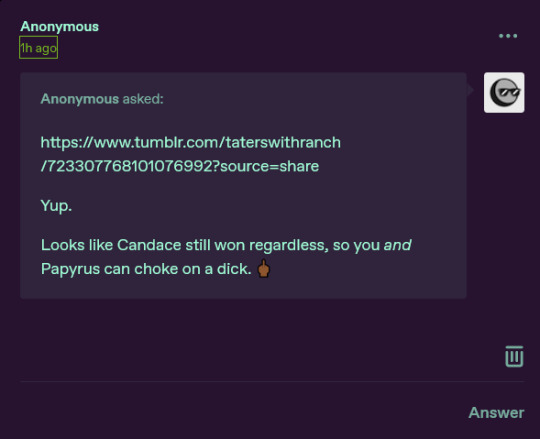
So if you get anon hate like this, there is a few things you can do. (Also once again the person linked is totally innocent, anon is just using a link to them for some reason, do not bother them)
First of all, Tumblr made it so only people who have accounts and are logged in can send anons AT ALL. So if you want to you can click the three little dots in the upper right corner and report them

Anyways once you're there, select the type of harassment you're getting, after consulting a few people on discord I decided it was the second to last one.

Then of course you fill out the little form

Afterwards you can hit "Submit and Block"

Fun fact: when you block an anon you permanently (there is no way to reverse it) block their IP address and they can't send you any more anons, also as a bonus, if you've received a LOT of anon hate and then you block one of them, reload your inbox to see how many it got rid of, because it might have just been one loser spamming you. If you don't feel like reporting them then that's fine too, just block those suckers.
And finally, you can take solace in the fact that you could never be as big of a loser as the anons sending people hate.
6K notes
·
View notes
Text
We need to talk about tipping.
So, for massage therapists, 20% is industry standard. This is because it's 1, manual labor where 2, the massage therapist needs to be attentive to your individual requests and needs. But there are scenarios where you shouldn't tip that much, shouldn't tip at all, and should tip more.
So:
Don't tip if you're getting massage through a doctor's office, like a chiropractor or hospice provider
Don't tip if your massage provider has specifically stated they don't take tips. It's most common among specialists who see clients with specific issues, like CF/ME or migraines.
Tip less if you didn't like the massage, had your time cut short, or if the therapist wasn't adaptive to your needs — to a point. If you scheduled a Swedish, don't tip less because you didn't get deep tissue.
Tip less if the therapist wasn't very involved in your treatment, such as a soak or a sauna treatment.
Tip more if you're at a resort/hotel spa. HR and managers often promise a higher tip rate (23-25% is common) and include tips as part of the hourly commission when baiting hiring employees. Plus, the percentage per massage hotels pay is always lower, so despite living in a more expensive area, massage therapists often make the same as they would in a mid-range spa. Those tips cover living expenses the hotels wont.
Tip more if it was amazing. If you got off the table and all your issues were gone or if it was the best massage you've ever had or if they worked longer on you than you paid for, tip extra. If you're going to write a good review, if you request that therapist and only that therapist from now on, or if you're going to recommend the spa/therapist to others, those are all signs you should be tipping extra. How much is up to you, but anywhere between 25 and 30% is very appreciative. If you tip 50% or more, the massage therapist will make sure every massage you get from thereon out is the priority massage of the day.
Tip more if your personal needs made it harder on the therapist than it should be. If you had the therapist running for all sorts of special requests or if you have a disability/allergy that was difficult for them to accommodate or if you're obese and you booked a Thai massage, tip extra. If you were late 15 minutes or more but still had all your areas of concern addressed, if you were late 10 minutes or more and still got your full time, if you're pregnant and had to get up to pee every ten minutes, tip extra.
Tip a normal amount of it was a good-to-great (but not life changing) massage with regular parameters.
Do NOT tip less if you showed up late and didn't get your full time, if you wanted a more expensive service for less and didn't get it, or if you didn't inform the MT about something and had a bad reaction from it.
1 note
·
View note
Text
today on ao3 tips, here's a quick follow up to this post about the ao3 "mark for later"/TBR/save for later function! ive seen some stuff going around lately lamenting that there's no easy way to filter out "character x reader" or "character x OC" fics from search results, but there absolutely is!
very quick and simple fix, just add "-reader" and/or "-original*" to the "search within results" bar (not "other tags to exclude", which might be where the confusion is coming from). it looks like this:

here is what it looks like with both filtered out:

the "*" after original is an indicator for the filters to catch the "original female--", "original male--", and "original character" tags, which is why is should be included! as a caveat, this also removes anything that has the word "original" in the summary or tags, so do be aware of that. (meaning this will also grab anything that has original characters tagged even if they AREN'T in a pairing, plus anything that uses the word "original" in the normal sense)
also, || designates "OR" for the filter search, so it is optional (and can be replaced with just a simple space) but i like to include it to be extra sure. i have checked and both results work.
anyway, happy reading, everyone!
5K notes
·
View notes
Text
So You Want to Tumbl?
There are lots of newcomers here these days, and I thought I'd spell out how to begin and what it means to ‘curate your own dash’ for folks who haven't grown along with Tumblr for the past decade.
If you're coming from a platform where content is fed to you, Tumblr can seem barren and intimidating in the beginning. But that's actually a good thing! What it means is that you will see what you want to. If you're in a fighting mood, go find political discourse. If you're feeling fragile, make your dash nothing but art and nature.
How to begin?
You’ve made your blog and picked out your icon (seriously, choose an icon: otherwise you’re indistinguishable from bots). Feel free to be anonymous. Most of us are, and it’s wonderful to have a place that’s not tied to your Real Life. Here you can be a fandom freak (like me!) and no one judges you and your boss will never find out.
Now seek out tags that interest you. For example, I was just looking through #moss because I like peace and green things and old-growth forests. (And, apparently, beautifully naked fae-men, heh.)
Now you follow that tag (if it's a popular tag, it'll say how many followers the tag has, which is beneficial to know if you're making a post that you want to reach all its interested audience) and posts with that tag automatically fill your dash. Voila, you have begun to curate your experience!
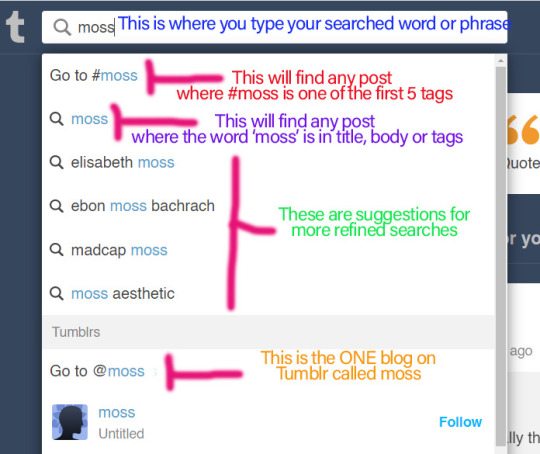

Do Follow: tags; blogs in that tag that you like; people who comment on posts in the blog/tag you follow that seem like they’re up your alley. The more people you follow, the more varied and nuanced your dash is.
Don’t Follow: people who make comments or posts that raise your blood pressure. Topics that upset you. Discourse that has you arguing in your head for the rest of the day. PLEASE avoid toxicity. Real Life is hard enough.
How to be Social and Interact
If you want to find your tribe and interact, it’s best to start following individual blogs. (If you follow a blog, they have an opportunity to follow you back. Simply following a tag is a passive, one-way street.) To Tumbl is to be in a vast cocktail party, and you need to mingle and eavesdrop to find the things that galvanize you.
How to be seen and heard

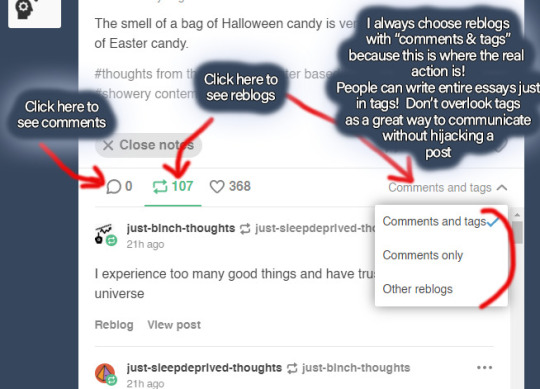
💬Comment on posts (please always stay positive and enthusiastic: we really try to avoid toxicity). You can read other comments (and reblogged comments) by clicking on the notes:
🔁Reblog posts you like, both to show your support and to show other people what kind of things get you excited. Reblogging is essential to the tumblr ecosystem, because it’s the only way posts move around and get seen. You can also “like” posts, but that's a much more passive way to interact. Also, reblogs and your own original posts show up on your blog and prove that you're not a bot.
Create your own posts and remember that the first 20 tags you use are essential, because that’s what gets you seen (and followed) by strangers. Tags 21-30 are good for searching and archiving on your own blog, but they don’t count on the dash. Instructions on how to Make A Post.
Participate! Once you find your crowd, you’ll discover that there are always things going on. For example, in fandoms, we’ve got writing events, art events, crafting and cons. The more you try to be involved, the more new friends you’ll discover. Tumblr allows for such an organic community. One person has a thought, and many others build on that thought, creating something far greater than the sum of its parts.
There is no real algorithm beyond using those first 20 tags. This may be discouraging to folks who are used to working an algorithm, but we like it fine here, because it keeps everyone real and keeps obnoxious social climbers/capitalists out of your face.
Be patient! Just like in real life, when you find yourself in a crowd of people you don’t know, it takes a while to form connections. Watch and listen, and learn to read the room. Honestly, the thing that will win you the most friends/followers is honest enthusiasm about your space.
Don’t aim for the big names to become your new buddies. You’re more likely to find a thriving coterie among other fresh faces. Don’t assume that because they’re small or new they have nothing to offer you. Often, this is the fire that keeps any given corner of Tumblr going.
Tumblr Etiquette
NEVER REPOST (without explicit permission). Reposting is when you cut and paste from someone else’s content and then make it into a brand new post under your own blog name. That is stealing and is very condemned. Reblogging is when you use 🔁and the OP (original poster) remains attached to their post and continues to see and be in charge of interactions.
Reblog in addition to Liking. A post that you 'like' is static. You are not helping it to get to a broader audience. If the post or poster is something/someone you support, then REBLOG that sucker: it deserves to fly!
Reblog and add your own content. One of the best parts of Tumblr is that you can comment on a post, or even add to it in your reblog (as long as you’re not being a dick, okay? Or changing the topic, which is known as ‘hijacking a post’). Here is a wonderful example of the Tumblr ecosystem at work, where someone had a thought, other people had thoughts about that thought, and then a bunch of artists jumped in. Tumblr posts BUILD COMMUNITY, and you can be a part of that conversation. (Do try to refrain from reblogging with vacuous comments just because you want people to notice you rather than because you actually have something to add, though. That’s just clutter.)
The most important part of “curating your experience” is learning to Block.
You can block individual blogs, Anons, people in the comments that you find upsetting. Here's a post on How to Block.
Block entire tags or keywords if they are triggers for you. (Here is a post on how to do that.)
Blocking is self-care. It is not a platform to demonstrate to the community how much you hate someone and how they should, too. Usually the blocked person never even knows you’ve blocked them. If they do something egregious (like tell you or someone else to kill themselves), then ‘Report’ them.
You can block something (like #US Politics) if you can’t handle it at the moment, and then unblock it later. Block a friend if they’re spamming something you don’t like and then unblock them later. It’s all good! You are in control of what shows up on your dash.
But doesn’t this mean my dash will be single-topic and boring?
The simultaneous joy and pitfall in following individuals is that MANY blogs are not single-topic. You will be exposed to all kinds of reblogs/ideas/other people from the folks you chose to follow, and can decide for yourself if you (a) want to be involved in that topic, (b) are indifferent to that topic, or (c) want to run from it screaming.
Also, the blogs you follow will move from hobby/theme/passion over time, and you can move with them, appreciate their new topic without vibing with it, or drop them altogether.
And THIS is how you curate your dash, my friends.
***Install New XKit extension. It’ll make your life easier!
***Here's the Tumblr Help Center, where you can learn more details.
#welcome to tumblr#new users#tumblr#tumblr etiquette#tumblr tips#how to tumbl#mojo muses#twitter refugees#long post
6K notes
·
View notes
Text
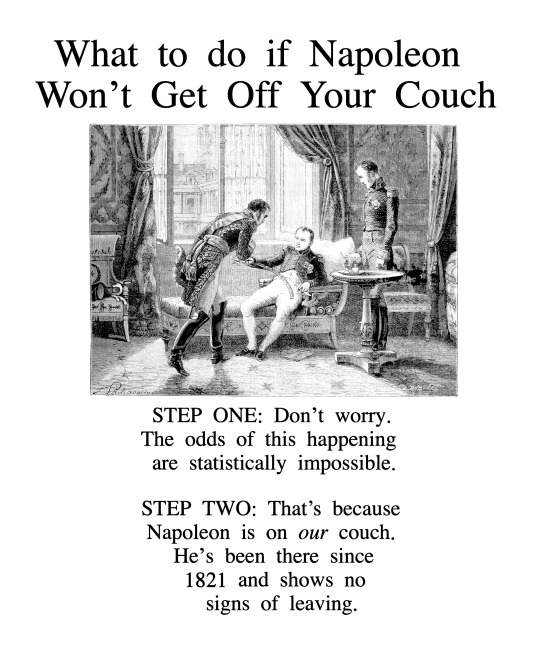
#What to do if Napoleon Won’t Get Off Your Couch#tips#tricks#life hacks#helpful hints#advice#Napoleon#France#history#etiquette
218 notes
·
View notes
Text
Fellow redditors who are new to Tumblr are welcome here, and while there aren't any moderated rules like in subreddits, there is a sort of social decorum that's pretty easy to pick up on.
Some tips if you're new though:
- First of all: If you're new, for all the that is sensible in the world, change your icon, make a bio (doesn't have to be grand, but a little blurb is good), and/or make a post stating that you are not a bot, even if your blog is otherwise empty. This site is often plagued by spam bots, and blank blogs with default icons are often blocked out of self preservation by users.
- Second of all: Go add "X-kit Rewritten" (or "New X-kit") to your browser extensions.
- THIRDLY: You can follow tags and specific users to curate the content you want to see on your dash. Blocking doesn't stop you from seeing someone's content but you can add terms, tags, and names to your Blacklist (found in blog specific settings) and shield yourself a bit that way. If you have one of the extensions mentioned above, you can also block specific posts.
- Commit to the bit; If there's a joke, a bit, a playing going on, contribute (if you want to)! Makes it more fun.
- Nothing dies here. There are still posts from 2008 circling around and still making laughs. Don't worry about when a post was made, if you like it, reblog it!
- Reblog things!! No seriously, if you like something, the upvote system here is to reblog it so other people can see it. Likes are more like your private stash of posts you've liked or seen already (you can make likes and follows private in settings). Reblogs do not need a caption, if you've got nothing to say, don't. Lurk all you want, make your blog reblogs only, it's okay!
- Want to say something but don't want too much attention? Reblog and type in the tags area instead of the caption area. Doing this is more talking to yourself and maybe a few followers in spirit. If people like what you had to say, they'll add your tags to a post, just be aware. If you don't want that, a basic courtesy for yourself is to tag your post #do not reblog OR #Do not screenshot caption
- Tumblr tags can have spaces in them! They're separated by commas.
- You can make sideblogs! Got multiple interests but don't want them all in one big blog soup? Create a side blog to curate what you post and reblog. Make sure to use tags if you want that extra bit of organization.
This isn't everything, we'd be here all day if I listed it all, but it's a good few tips. This is a safe place for new peeps trying to get their feet wet. Please enjoy yourselves, be safe, and have fun.
#reddit#reddit exodus#reddit migration#reddit blackout#reddit refugee#tumblr#tumblr tips#how to tumblr#tumblr 101#tumblr etiquette#tumblr help#new to tumblr
754 notes
·
View notes
Text
Okay, I want to follow this content. What do I do?
Hello everyone.
So given the recent raise of "tag me!" replies in fics going around Tumblr, and given the recent awareness post about how disheartening, annoying and sometimes disappointing it can be to only get that kind of engagement — I've thought it was a good idea to explain what you can do if you want to follow content.
Basing on what Dis already added to the original post, this is a more detailed list of what options you have when enjoying the content you see.
I liked this prompt, I wish to see all the additions to it. How can I keep up?
You can subscribe to the post!
Desktop: Left click on the three dots and click on "Subscribe to conversation"

Mobile: Go to the Notes and click the top right bell icon

I liked this fic the author posted and I wish to know when they post the next part. How can I be notified?
You have several options here:
Find their Ao3! A lot of authors crosspost on tumblr and ao3, or prefer to post a more polished version on ao3 later on. Whichever the case, you can go to AO3 and subscribe to the fic/author there if you'd like

2. Follow the author! Really. We don't bite. You can just follow the blog, as easy as that. Want to be notified any time they post anything? You can subscribe to the blog and get a notification when they post anything
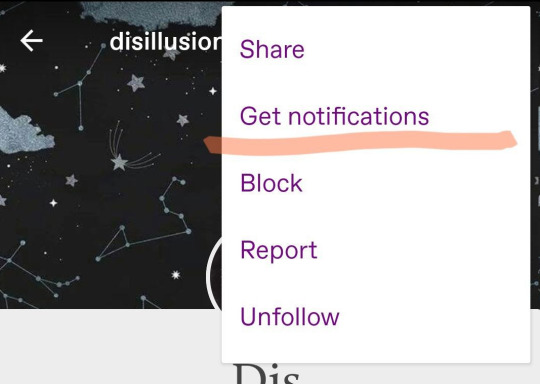
EDIT: THERE ARE "SECRET" DASHBOARDS, and one of them is a dashboard of all the blogs you have turned on notifications.
Blog Subscriptions Dashboard or go to Settings and turn on the tab in Settings -> Lab
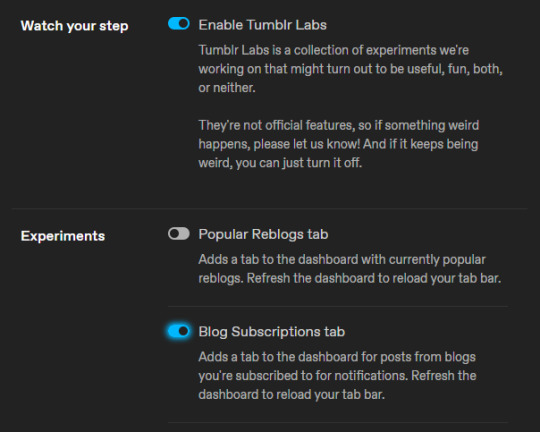
A post about more fun Tumblr dashboards
3. You can still request to be tagged if they continue! But don't let that be the ONLY engagement you do. Like the post. Reblog it. Leave a comment saying what you like, a keysmash, a lovely "hey i really like where this is going!" and then you can say "if you do continue, can you tag me?". 9/10 we would love to write down your name. I can't speak for everybody so it depends on the person, but we want to not feel like we are screaming to the void. Engage. Respond.
KEEP IN MIND: Tumblr is a reblog-based social media. There is no algorithm. We get readers ONLY via reblogs. Likes? Likes are nice but do nothing. You liked the art? REBLOG THE ART.
Another post about reblogging, why it doesn't feel annoying for authors and how you can reblog and add tags faster on desktop and mobile
UPDATE: Tumblr feature for desktop!!!!! If you hover with the mouse over a post and hit "shift+R", post is automatically reblogged!
I liked this oneshot and I wish to know if they will continue it.
If it's a oneshot, RESPECT IT. The author may not have plans for the story, or doesn't have the energy to elaborate. Or if they do, it will be waaaaay later.
Whatever the case, don't demand a continuation.
Really, don't. Is very rude.
Still want to shoot your shot and see if they continue it?
Reblog it! Say why you liked it! In the tags, in the same reblog, wherever! If the author gets inspired they will continue, but remember we do this for free in our free time, you don't know what their life looks like. Respect that.
PLEASE NOTE: You can still find them in AO3 and subscribe to the fic/author there.
I like the AU/Idea/Project, how can I follow any new content for it?
You can follow a tag!
A lot of authors have a specific tag for their AU/idea/project (eg. "plant princess au") that you can follow if you want to keep up. Just check the tags in the post and hit follow.
Desktop:

Mobile:
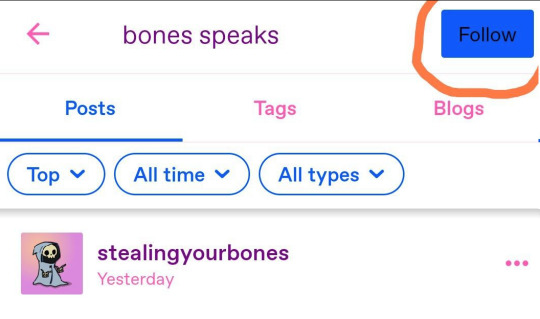
And that's it! If I have more ideas or examples I will add to the post.
Remember, the point is not to make fun or to make people apologize for the "tag me" replies. This is informative for newcomers and older users alike.
If you have any questions or worries don't hesitate to ask! 🙂👍💖
823 notes
·
View notes
Text
Classy Tip #2: Etiquette

Etiquette leaves a lasting impression.
“I've learned that people will forget what you said, people will forget what you did, but people will never forget how you made them feel.” — Maya Angelou
➽──────────────❥
Etiquette plays a vital role in shaping our interactions with others and creating positive relationships. For women, practicing good etiquette goes beyond just social norms; it becomes a reflection of self-love and respect. In this blog post, we will explore why etiquette is important for women, how it demonstrates respect for others, and how it empowers women to set boundaries and command respect from others.
• Expressing Respect for Others:
Practicing good etiquette as a woman demonstrates respect for others. By listening actively, using polite language, and showing consideration for others' feelings and boundaries, women create an atmosphere of mutual respect and understanding. This fosters healthy and harmonious relationships, where everyone feels valued and heard.
• Setting Boundaries and Commanding Respect:
Etiquette empowers women to set clear boundaries and expect respectful treatment from others. By understanding and asserting their rights, women can establish personal boundaries and communicate them effectively. This not only enhances self-esteem but also encourages others to treat them with the respect they deserve.
• Cultivating Self-Love:
Practicing good etiquette is an act of self-love for women. It involves taking care of oneself physically, emotionally, and mentally. By maintaining personal hygiene, dressing appropriately, and practicing self-care, women demonstrate their self-worth and value. When women prioritize their well-being, they radiate confidence and inspire others to treat them with the same level of care and respect.
• Nurturing Positive Relationships:
Etiquette helps women create and nurture positive relationships. By showing gratitude, acknowledging others' efforts, and practicing empathy, women build strong connections with those around them. These positive relationships not only bring joy and fulfillment but also provide a support system that uplifts and empowers women in their personal and professional lives.
• Leading by Example:
As women practice good etiquette, they become role models for others. By embodying respect, kindness, and consideration in their interactions, women inspire others to follow suit. This ripple effect can lead to a more harmonious and respectful society, where women are seen as equals and are treated accordingly.
➽──────────────❥
What To Practice:
Practicing good etiquette as a woman is not just about following social conventions; it is a reflection of self-love and respect. By expressing respect for others, setting boundaries, nurturing positive relationships, and leading by example, women create an environment where they are treated with the dignity and respect they deserve. So let us embrace etiquette as a powerful tool to cultivate self-love, foster positive relationships, and empower ourselves as women.
💖 Practice Good Table Manners:
When dining out or attending formal events, familiarize yourself with proper table manners. Use utensils correctly, chew with your mouth closed, and avoid talking with food in your mouth.
💖 Be Punctual:
Respect other people's time by being punctual for appointments, meetings, and social gatherings. Arriving on time demonstrates your reliability and consideration for others.
💖 Use Polite Language:
Choose your words carefully and be mindful of your tone when speaking to others. Use "please," "thank you," and "excuse me" regularly. Show respect and kindness in your interactions. This also shows people how you should be addressed as well. The energy speaks for itself.
💖 Listen Attentively:
When engaged in conversations, practice active listening. Give others your full attention, maintain eye contact, and respond thoughtfully. Avoid interrupting or dominating the conversation. This simple tip will help you leave a good impression that could open doors and navigate through the rooms you get into.
💖 Practice Good Phone Etiquette:
This is so important! When using your phone in public or during social events, be mindful of others around you. Keep your voice down, avoid lengthy or loud conversations, and be considerate of your surroundings.
💖 Mind Your Body Language:
Your body language can convey a lot about your level of class and sophistication. Stand tall, maintain good posture, and avoid slouching or crossing your arms. Use open and welcoming gestures.
💖 Show Gratitude:
Express appreciation and gratitude when someone does something kind or helpful for you. Send thank-you notes or messages to show your gratitude for gifts, favors, or acts of kindness. Be genuine. That's what stick with people in the end.
💖 Respect Personal Space:
Be aware of personal boundaries and respect the personal space of others. Give people enough room to feel comfortable and avoid invading their personal space without permission. It goes back to the Golden Rule: “Treat people the way you want to be treated.”
💖 Be Mindful of Social Media:
Use social media platforms responsibly and considerately. Think before posting, avoid engaging in online arguments, and remember that what you share online can have long-term consequences!

Etiquette is not just a set of rules; it is a reflection of the values we hold as women. By embracing good etiquette, we demonstrate our respect for others, set expectations for how we wish to be treated, and cultivate self-love. It empowers us to navigate social settings with confidence and authenticity, leaving a positive and lasting impression. Let us strive to incorporate etiquette into our lives, not only for the benefit of those around us but also as a testament to our own self-worth and self-love.
#classy tips#black women in luxury#classy black women#black women in femininity#feminine energy#soft girl era#soft black women#the soft life#classy women#feminine black women#feminine journey#etiquette#black luxury
98 notes
·
View notes
Text
one of the reasons (i said “one of” not “only”) young men are susceptible to this kind of foolishness is the reality that many women play games. we as men have to intreprent hints and deal with women who say “no” but mean “chase me.” who say “no” but mean “yeah.” ughh it can be ugly. the way to proceed as guys is to always (always) take “no” to mean “no.” doesn’t matter if she’s playing a game, wants to be chased, wants to see how determined you are or whatever. don’t risk your freedom. if she says “no” then it’s final answer and just move on.
#dating#relationships#communication#miscommunication#mixed signals#understanding women#dating tips#gender dynamics#relationship communication#emotional intelligence#dating etiquette#women's perspectives#clarity in relationships#navigating romance
53 notes
·
View notes
Text
Roleplay Tips: "Actionable Responses"
We have all experienced, or will at some point in the future, a thread that feels like it is going nowhere. It's that feeling of reluctance to pull up the draft, of realizing it's the third or so time of experiencing dread when you see that other person respond.
You're bored with the thread. That, or you want to continue and just can't seem to think of what to do next!
There are a number of reasons why this can happen, but one of the most common ones is a lack of an actionable response from your partner. In most cases, deciding to wrap up the thread is the best thing to suggest...but most of us are just too "polite" to do that, huh? 😉But that's a post for another time.
So, what is an actionable response? Simply put, it's a reply to a thread that manages to give direction to your partner. This has NOTHING to do with matching length of post! It's just a matter of being aware that this is a collaborative effort.
Here's an example:
Character A: "I think we should invite our friends out to a party."
Character B: "That's a great idea!"
Character A: "It'll be a formal party. I'm going to work on the invitations tonight. I'll really go all out and make it fancy!"
Character B: "Oh, I can't wait to see what you come up with! I'll be sure to wear the red dress I got over the weekend."
Character A: "I'm sure it looks stunning on you. I don't know what I'm going to wear yet. I think I need to figure out the venue and the details first."
Character B: "You are going to knock it out of the park! You're always so good at organizing everything!"
So, what happened? The conversation above isn't bad! However, there was "burden" placed on the writer of Character A each time. The writer of B has responded each time in similar length, but gives A little to no idea how to continue the conversation. Each reply made it the responsibility of the writer of A to come up with the direction for the conversation. Here's the breakdown:
A: Starts with the opening prompt (the party)
B: Agrees with idea
A: Elaborates on prompt
B: Enthuses about prompt, brings up new subject (dress)
A: Compliments B, brings up new subject (uncertainty)
B: Reassures A
Sometimes your character requires noncommittal responses, and this is OK to do once in awhile! But think about this in real life: If you met someone who was only this reactive to your comments and never really asked about you or your actions... Wouldn't it get a bit exhausting to talk with them? At the very least, they would appear polite but uninterested, and interactions would tend to be short.
Here's a better example for the above, one with actionable responses from B.
Character A: "I think we should invite our friends out to a party."
Character B: "That's a great idea! Which friends, though? The ones from work or school?"
Character A: "Why not both? I think it'd be cool to combine our social groups. Unless you think they wouldn't get along…?"
Character B: "Well, you know how wild I get around Stacy on the dance floor. I wouldn't want it to reflect bad on my performance review …"
Character A: "That's true, you two can get pretty unhinged. But I was thinking of theming it up to be more of a formal party. Like, make fancy invitations and everything!"
Character B: "Oh, that sounds amazing! And less likely I'll start twerking, although the possibility isn't zero. Do you need any help with the invitations? Or anything else?"
Character A: "I should have the invitations under control, but I'd love it if you could brainstorm the decorations. I want to go for a vintage 1950's vibe."
Character B: "I am already making a Pinterest. This is going to be great! Oh, and I just bought the cutest red dress that'll work perfectly for the theme! Do you know what you want to wear? We can go window shopping later if you want!"
Character A: "That would be great! Do you have pics of the dress?"
The above interaction isn't just more equal in engagement, its flow and dialogue is far more natural and prompts more detailed responses! Here's the breakdown for this one:
A: Starts with the opening prompt (the party)
B: Responds asking for more details, prompting a new subject (guest list)
A: Answers, asks for B's opinion
B: Answers, brings up a third party that A can comment on
A: Makes a comment, but chooses not to pursue subject at length; brings up new point of discussion (formal party)
B: Gives opinion, offers help
A: Accepts help, provides further prompt details (party theme)
B: Gives opinion, offers up another subject of clothing, offers up potential next direction/goal of thread (shopping)
There is a lot more "work" involved on both sides in the above example. And this is just with dialogue alone -- using descriptors and physical actions (i.e B could pull up their phone and show A the photos of their dress, or A could have started to playfully mock imitate B's dancing) also gives the other character something to respond to. This works great for Muses who canonically don't say much or are generally quiet in certain scenarios!
The ultimate goal of writing Actionable Responses is to share the responsibility of the scene, so that one writer doesn't feel burdened with directing everything and eventually associate your threads with fatigue, even subconsciously. Communication also plays a big part, too! Your responses may be actionable, but if the other writer isn't picking up any of them, it's time to pause the thread and communicate ooc and see what's up!
"Oh no! I realized I don't write a lot of Actionable Responses! Does that mean I'm a bad writer/horrible person? Do all my partners secretly hate me? Is this why I don't get any responses?"
NO. Realizing the above only means you're learning something new right now, and it is up to you if you want to employ the above suggestions or not. This thread is not meant to shame people -- it is meant to educate, and maybe even put into words what other writers feel, so that they can share and point to it when they feel responsibility is unbalanced in a thread.
#roleplay tips#roleplay etiquette#roleplaying tips#rp psa#writing tips#admin: psa#admin: roleplay tips
222 notes
·
View notes
Text
A beginners guide to having a fun time at a small show (some of this also applies to bigger shows)
If you've never been to a show before or you've only been to big shows going to a small or diy show can be confusing. The rules and etiquette of attending a small show are different from what you may have experienced or heard about at a bigger show. I'm here to try to give you some tips and pointers on how to have the best night and help everybody else around you have a great night as well.
Small shows are community based, if you only take one thing away from this post let It be that. The environment is that of friends and acquaintances, this includes the bands that play. The members of these bands are just people who are part of their local scene and enjoy playing music. They should be treated like any other member of the audience, you can be friendly and start up a conversation or compliment the set, but remember they're just a stranger who enjoys the same music you do.
Your first show in a new city or venue? The environment and social expectations of a scene can vary from city to city and venue to venue. If it's your first time being somewhere it's always better to follow the social cues of others rather than looking like an ass. If you don't know what's going on try asking somebody:) Many people in the scene are very happy to welcome newcomers and explain the ins and outs of their individual local seen.
Queuing (if you want "barricade"), for 1500 to 700 person capacity venues, depending on whether or not the show is sold out and the artists popularity, I would suggest showing up 2-4 hours before doors. This would be for places like House of Blues, that are arguably not a small venue, but I'm including them anyway. Anything under 600 I would show up 2 hours to half an hour before doors. Anything under the 300 mark doesn't usually have "barricade" per se, the crowd moves around a bunch and showing up early will not help you get a better vantage point. Note: I never show up anywhere more than an hour before doors and I can usually get pretty close to the stage.
Respect the venue and the people working there, if you're attending a small show, especially a basement show, it's really important to be extra aware of where you put your trash and how you're acting. Oftentimes these locations are rented halls or somebody's actual house. This means there wont be any staff that are being paid to clean up after you, not that you should be messy at larger venues. But at these venues especially try to stick around and help out if you can. If the venue is left trashed they may no longer be willing to host shows in the future.
Braving the pit, there are only three rules I would suggest for the pit, and they all boil down to respect. First, if somebody falls, drops something, or seems like they're having a hard time _always_ stop what you're doing and help them out. Second, don't try to be tough, if the pit is too aggressive for you you can either jump around on the side of it or dance somewhere else. Third, unless you're actively pushing somebody always try to keep your elbows tucked, especially if you're tall. It can be really stressful being a short person in a pit that's just a sea of elbows.
Say hi! not just to the band, to the people around you at the show as well. I know this one can be hard, if you went with folks it's very easy to become insular, and if you went alone it can be scary to talk to people by yourself. Something that I've found really helpful is hanging out outside, either between sets, or after the show (you don't need to smoke I often just cool down with a water bottle). Many people will be excited to see a new face and if you seem open to it they might start up a conversation. If they don't and you don't know what to talk about, try complimenting something somebody's wearing, it can often lead to a story that then can lead to a conversation.
Always show up for the openers, even if you don't care about barricade, you should try to show up for the openers both by physically being there and by paying attention and giving them your energy. I've discovered a lot of really wonderful bands by checking out the openers before a show, learning a couple of their songs, and then really getting into it once they're playing.
Take care of yourself, make sure you come having eaten and drunk enough water, I even suggest bringing a water bottle. Most venues will at least have access to water but it's always good to be self-reliant just in case they run out or something happens. Depending on the style of venue they may require this to be empty, If they do require that, you can usually fill it up once you get inside.
Dress appropriately, especially if you're planning on being up at the front at a punk or hardcore show. You will probably end the night covered in other people's sweat and beer, this is amazing revel in it. But, it's maybe not the time to pull out your favorite shirt, unless you want that for your favorite shirt (in which case I love you)
And last but by no means least, always always always thoroughly check the flyer or event posting to make sure you know if the show is a sober / straight-edge show or not.
(edit) A couple of additional tips that have been suggested in the tags, as well as a few new ones from yours truly
Always bring earplugs, some venues will have them for sale but they're not great quality and they can run out. If you plan on going to a lot of hc/punk shows, or honestly a lot of shows at all, I suggest investing in a $15-25 pair, it'll save your hearing in the long run.
Keep your toes safe! Even if you don't plan on going into the pit it's a good idea to wear closed-toed shoes. You'll be in close quarters with people wearing boots who probably won't be able to tell if they are accidentally stepping on your flip flop shod feet. Shows also involve standing for a number of hours so you may want to think about comfort. I suggest wearing at minimum a converse style shoe with a little bit of structure around the toe. I personally always wear boots with a pair of insoles, but that's just me and my rickety ankles.
do you want to wear a bag all night? If so, that's fine, but you're probably not going to be able to enjoy the pit or dance that much. Some smaller shows will have coat checks, but a lot under 300 capacity won't. I generally suggest against just hiding your bag in the corner, I've seen a lot of people get their stuff stolen. So, pare down, I don't even bring my whole wallet, just a credit card, ID, subway pass, phone, keys, and some cash in case the venue only accepts cash or if something happens and I need to get a taxi home. If you end up keeping stuff in your pockets make sure it's secure. If I know my pant pockets are particularly bad at holding things I'll put my cards and cash in a sandwich bag and pin it to the inside of my pocket. This way it's still accessible but won't fall out.
Picking up merch? Do it after the show, merch rarely sells out at smaller shows. So, pick up anything you want after the show, carrying it around all night can be annoying and you might lose it.
Jewelry? If you plan on going in the pit I wouldn't wear dangly earrings or necklaces, they can get caught on things and ripped out or off, which is not fun at all!
I hope you found this helpful<3 if you have any additional questions or concerns please feel free to dm me or leave me an ask and I'll try to get to it
439 notes
·
View notes
Text
Reminder: blacklisting tags/ words is not a judgement nor a reflection of you
Here, on tumblr, blacklisting tags and filtering out specific words has no judgement attached whatsoever!
I promise you, it’s okay!
You can put any and all stuff you don’t want to see into your filtered tags/ filtered words
It doesn’t mean the stuff you filter/ blacklist is bad, it doesn’t mean you judge people or people’s posts
Some examples I blacklisted:
“#sdv” – that’s “#stardew valley”
“#minecraft”, “#smp”, and anything else relating to popular Minecraft YouTubers
“#sylvanian families”
I don’t know how many tags about dan & phil and their “phandom” (not to be confused with the Danny Phantom phandom)
I just don’t care for these topics and that’s why I preemptively put them to be filtered
And you can – btw – also put user URLs into the “filtered words”, you don’t even need to type the whole URL if it’s unique enough, usually the first 8 letters are enough for the filter to block the URL/ user
Curating your online experience is so easy on tumblr, please do it
There is no reason to scroll through things you don’t want to see
So please see this as your permission to filter/ blacklist/ outright block topics and blogs you don’t want to interact with, you don’t need a reason
You do not ever need a reason to block another tumblr user, blocking is without judgement
And I’m honestly still unlearning this myself because sometimes I can’t reblog from someone and that shows me I’ve been blocked by the OP and that makes me go “hey :(” – but it’s okay people block my URLs, it’s their right to do that
38 notes
·
View notes
Text

I was paid 10 dollars for this. I still have not listened to a single episode of TMA.
Commissioned by my friend @sharks-n-pipe-murder
#fandom art#i don’t know if saying how much i was payed is bad commission etiquette or not#It’s for a joke#it’s fine I think#crackship#jonathan sims#john ward#john faith#faith airdorf#the magnus archives#JonJohn#I am so mad that I’m proud of this because I get whiplash every time I try and take it seriously#It’s like being able to lick your nose but you just dipped the tip of it in drain cleaner#it’s great.#2023
38 notes
·
View notes